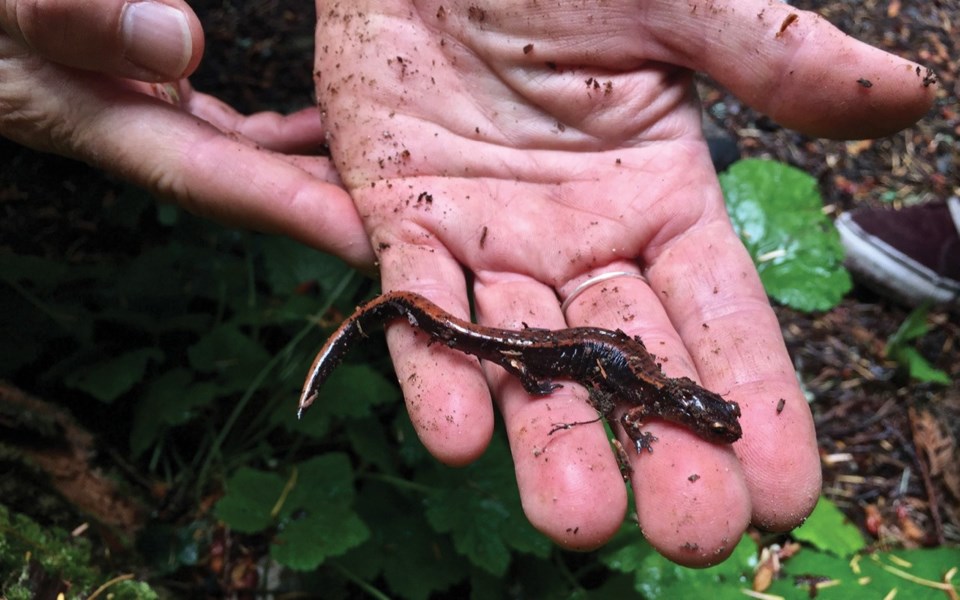The message came in late—could I help out guiding a nature walk the next day?
Of course you can, people I know would snicker. But then, they really don't know me. Despite having been a university lecturer and frequent public speaker, anything that comes with the weight of expectation unnerves me. All of a sudden everything I know seems trivial, unworthy of sharing. How could I possibly help on out on a nature walk when all I do is write about it? Besides, only keeners sign up for nature walks, I fretted, and they'll want to know about birds and ferns when all I have to offer are anecdotes about creepy crawlies like snakes, frogs and bugs.
But was I selling myself short? After all, I'd likely absorbed enough ancillary bio-info from a range of geeky associates and visiting bioblitz scientists to fill an entire book (which, I realized, I had already done). And the man who made the offer—Eric Wight of Backroads Whistler, a well-known trader in Golden Dreams (of the river variety) and other eco-touristic delights—knew it.
"You'll do fine," he coaxed. "It's leisurely—these people are on vacation and just looking forward to a fun morning on the trails."
Still, I demanded a wingman. A mentor. However briefly, I needed to formally apprentice as something I'd more-or-less been all my adult life but never quite owned—a Nature Guide.
With no idea what to expect, I rendezvous in the morning with three other guides (all exceptionally experienced) at the designated hotel. A U.K. tour group that has pinballed through Western Canada for 10 days from their starting point of Calgary rolled into Whistler the previous eve. There are 30-something and the plan for our three-hour tour (I hear the Gilligan's Island theme song playing...) is to divide into a fast-walking group with little talking, a slow walking group with lots of talking, and a group somewhere in the middle with a reasonably equal walk/talk ratio. That will be my posse, and I'm assisting Janice, who, in addition to having done this a bazillion times, is super knowledgeable and super nice.
As we head through the village, the first sunny day in what seems forever affords an opportunity to talk about Whistler weather. Well, if you can't do that without thinking you can't claim local status, and Janice and I have no problem lamenting our oddly hot spring followed by a dreary June-uary. That breaks the ice, so to speak, and we're off to the races.
At Olympic Plaza, the first nature Janice fills the guests in on is human nature: a sprinkling of Whistler history, hubris and the 2010 Olympics. They're all rapt, and I realize I'm going to have to expand my own information repertoire to anthropological concerns if I am to succeed at this in the future. To wit: It's great to learn about how red squirrels store nuts in their cheeks, but where's that bobsled track and how fast can you actually go in one?
Speaking of red squirrels and their nuts, as we cross into the Montebello wetland a discussion erupts over whether that's where the expression "cheeky" comes from; the Wallace and Gromit-like question will consume many for the duration. Soon we head into the forest where there's no end of things to talk about, starting with bear awareness and the abundant bear sign on the trail—munched dandelions, bear poop, and claw marks on trees. Janice expertly delivers the main points and answers questions about how many bears there are in Whistler, how they use trails, and hibernation, then throws it over to me to deliver arcane information about how skunk cabbage lures bears from dens in the spring and helps them clean the winter cobwebs from their intestines. Suddenly we're a team, and I relax considerably. We discuss invasive plants, then Devil's Club and why it has that name, how First Nations use the inner bark as a salve. When Janice dishes on logging it opens up the topic of tree diversity and ages, nurse stumps and the forest's cycle of life. The Brits are mesmerized by the simple fact of trees growing on trees.
But I have an even better party trick. Since it has been raining and the ground is wet, I figure I can find a salamander. Fortuitously, I quickly turn up two long-toed salamanders, with their glistening yellow-stripes. Boom. Out come the cameras. Now it's a treasure hunt.
But it's also a hike and Janice sets a good pace up and over the west side hills of Lost Lake. Here, I point out coral mushrooms, bracket fungi, triple-layered symbiotic lichens and a moss called "fairy vomit" to folks at the back of the group, as Janice holds court with other wonders up front. Soon we've circled the lake with talk of birds, fish ladders and the lake's amazing western toad population. As we head back, satisfied chatter ripples through the group.
I needn't have worried about failing at this job. Nature, as always, makes it easy to impress.




